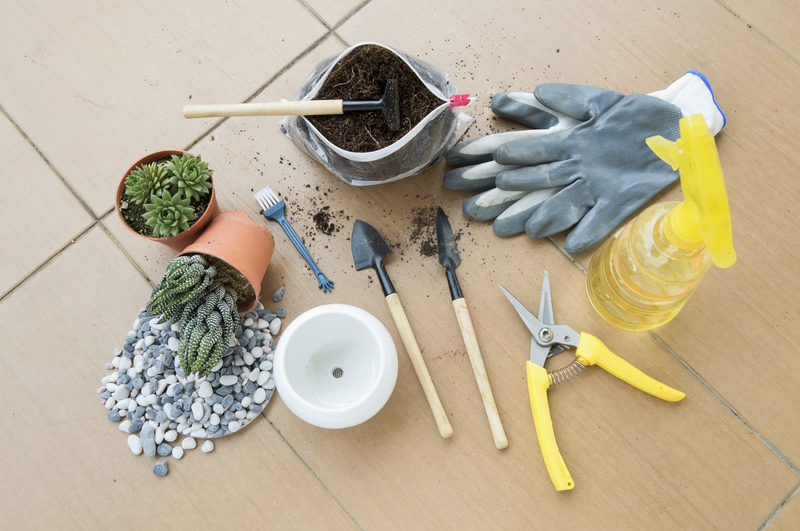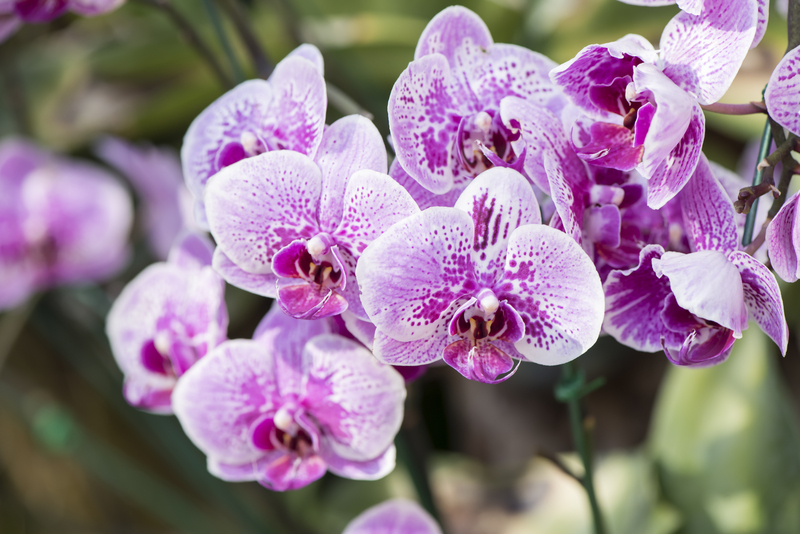Ensuring Your Garden Plants Survive the Winter Chill
Posted on 17/06/2025
Ensuring Your Garden Plants Survive the Winter Chill
As temperatures begin to drop and frost settles in, gardeners everywhere start to worry about how best to protect their beloved plants. If you wish to ensure your garden plants survive the winter chill, a mix of preparatory steps, winter care, and smart planting decisions can make all the difference. This article offers in-depth, actionable advice for safeguarding your plants and fostering a vibrant garden year after year.
Understanding Winter's Impact on Garden Plants
Winter brings unique challenges such as frost, fluctuating temperatures, reduced sunlight, and desiccating winds. These factors can deeply affect the vitality of your garden. Some plants can go dormant while others may be susceptible to root or foliage damage. Gardeners should not underestimate winter's ability to compromise even the hardiest flora.
- Frost: Ice crystals can rupture plant cells, causing wilting and dieback.
- Desiccation: Cold winds steal moisture faster than roots can replenish it, leading to winter burn.
- Fluctuating Temperatures: Warm spells cause premature budding, rendering plants more vulnerable when cold returns.
- Deep Freezes: Extended cold spells freeze the soil, restricting water and nutrient absorption.

Before Winter: Preparing Your Garden for the Chill
1. Choose Hardy Plants and Thoughtful Placement
Selecting the right garden plants for surviving winter chill is crucial. Refer to USDA Hardiness Zones and consult local garden centers to ensure your plants are suitable for your climate. When planting, position sensitive species in sheltered locations, such as near fences or evergreen windbreaks.
2. Mulching: Nature's Insulation
Applying a layer of mulch is one of the most effective tactics for helping garden plants survive winter freezes. A 2-4 inch layer of organic mulch (straw, bark chips, shredded leaves) protects roots from extreme temperature swings and moisture loss.
- When to Mulch: Wait until the ground has started to freeze to avoid providing shelter to plant-harming rodents.
- How Much to Use: Aim for 2-4 inches, being careful not to pile mulch against plant stems or trunks, which can harbor disease.
- Best Mulch Types: Straw, pine needles, shredded bark, composted leaves, and even well-rotted manure can help insulate soil.
3. Watering Wisely Before the Freeze
Well-watered soil retains heat longer than dry soil, offering roots a buffer against low temperatures. In autumn, keep your watering schedule consistent until the first hard frost.
- Water deeply but infrequently -- aim for a good soak to reach the entire root zone.
- Watering should be done in the morning so excess moisture evaporates, reducing the risk of fungal diseases.
- For evergreens, an extra drink just before the ground freezes helps prevent winter burn.
4. Prune With Caution
Proper pruning before winter can help plants survive cold weather, but mistimed cuts may do more harm than good. Trim away any diseased or damaged branches, but avoid heavy pruning, as it can stimulate new growth that's particularly sensitive to frost.
Essential Winter Protection Techniques
1. Covering and Wrapping
Physical barriers are indispensable for protecting garden plants from harsh winter chills. Different materials serve various protective functions:
- Burlap: Wrap sensitive shrubs and evergreens with burlap to shield them from cold winds and sunscald.
- Fleece or Frost Cloth: These lightweight fabrics offer frost protection without smothering plants.
- Cloche: Place cloches (glass or plastic domes) over vulnerable perennials and young vegetables to create a mini-greenhouse effect.
- Plastic Tunnels: Use for rows of veggies or flower beds, but vent on warm days to prevent condensation and mold.
2. Protecting Container Plants
Potted plants are especially vulnerable during winter, as their roots are exposed on all sides. To enhance winter survival:
- Cluster pots close to buildings for extra warmth and shelter.
- Wrap containers with bubble wrap or several layers of burlap for insulation.
- Elevate pots off cold surfaces using pot feet or bricks to allow drainage and reduce chilling.
- Move the most fragile specimens into garages, sheds, or basements as appropriate.
3. Creating Windbreaks
Wind can be just as damaging as frost. Set up temporary windbreaks made from burlap, snow fencing, or even stacked straw bales to shield tender perennials and evergreens. Plant permanent windbreaks of thick hedges or sturdy shrubs for long-term protection.
Winter Care: Attention Through the Cold Months
1. Monitor Moisture Levels
While most plants require less water in winter, it's important that the roots do not dry out completely. Check soil moisture regularly, especially during dry spells or for evergreens, which continue to transpire throughout winter.
2. Mind the Snow
- Snow as Insulator: A layer of snow can act like a blanket for your garden, shielding plant crowns and roots from severe cold.
- Heavy Accumulation: Too much snow can cause branches to break. Gently brush snow off shrubs and the lower limbs of trees using an upward motion to prevent snapping.
- Ice Damage: Refrain from attempting to remove ice, as this can do more harm than good.
3. Watch for Hungry Wildlife
Deer, rabbits, and rodents may see your garden as a food source during hard winters. Protect tree trunks using guards, deter rabbits by erecting wire fencing, and avoid mulching up to the bark to discourage rodents from nesting.
Post-Winter Care: Helping Plants Recover
As winter recedes, your attention should turn to gently waking the garden up:
- Remove Mulch Slowly: Once the threat of hard frosts has passed, begin clearing away mulch gradually to avoid shocking plants with sudden temperature changes.
- Prune Winter Damage: Cut back any branches or stems showing dieback, making clean, angled cuts to foster healthy regrowth.
- Feed and Water: Resume normal watering schedules and begin spring fertilization when new growth appears.
Expert Tips for Maximizing Survival Rates
- Know Your Microclimates: Within any garden, there are pockets that are slightly warmer or cooler than others. Take advantage of these zones by grouping vulnerable plants in the most protected areas.
- Plant Diversity: A mixed planting scheme is more resilient to winter stress. Some will thrive, while others recuperate--guaranteeing year-round garden appeal.
- Consider Raised Beds: Elevated beds drain better and thaw faster in spring, which can help prevent root rot and give plants a head start.
- Try Temporary Greenhouses: Even a small cold frame or pop-up greenhouse can be a winter lifesaver for cold-sensitive species.
Ideal Winter-Hardy Plants for Your Garden
One of the best ways to ensure your garden plants survive winter chills is by selecting proven winter-hardy varieties. Here are some favorites:
- Perennials: Hellebores, Coneflowers, Daylilies, and Peonies routinely return after brutal winters.
- Evergreens: Boxwood, Juniper, Pine, Yew, and Holly keep your landscape alive with color.
- Ornamental Grasses: Feather Reed Grass and Switchgrass add winter texture and movement.
- Vegetables: Kale, Brussels sprouts, Garlic, and Leeks can handle cold with ease when mulched.
- Bulbs: Snowdrops, Daffodils, and Tulips rest through winter to burst forth in spring.
Common Mistakes to Avoid When Preparing for Winter
- Pruning at the Wrong Time: Late season cuts can invigorate plants into tender new growth, which won't survive winter chills.
- Improper Mulching: Too much or poorly timed mulch can smother root collars and invite rot or rodent infestation.
- Underwatering in Autumn: Dry soil freezes faster and can damage roots -- always water deeply before the ground freezes.
- Ignoring Plant Labels: Tempted by a beautiful flower? Double-check its hardiness zone for reliable winter survival.
- Leaving Debris and Diseased Foliage: Clean up garden beds to minimize pests and diseases overwintering near plants.

FAQs: Ensuring Garden Plants Survive Winter
Q: Can all plants survive the winter chill without protection?
A: Not all plants are equally hardy. Some perennials and evergreens are bred for cold, but tropicals, succulents, and most annuals will need extra care or indoor relocation.
Q: Is it advisable to fertilize plants near winter?
A: Hold off on fertilizing most garden plants in late autumn; doing so can spur vulnerable new growth that's easily damaged by frost.
Q: Should I continue watering in winter?
A: Yes -- especially for newly planted trees, evergreens, and during dry winters. Water during a warm spell when the soil is workable, but avoid waterlogging.
Q: How do I protect my roses in winter?
A: Mound soil or mulch around the base, shield stems with burlap, and avoid pruning until spring when you can assess winter dieback.
Conclusion: Enjoying a Winter-Proof Garden
Ensuring your garden plants survive the winter chill is a seasonal challenge, but with planning and attentive care, your landscape can emerge healthy and ready for spring's return. From strategic plant selection to smart mulching, vigilant watering, and proactive protection against the elements and wildlife, your garden will not just endure -- it will thrive.
By following these comprehensive winter gardening tips, you can enjoy a beautiful, resilient garden that stands strong against the harshest weather. Start preparing now, and your plants will reward you with lush growth and vibrant blooms once warmer days return.

